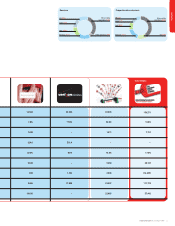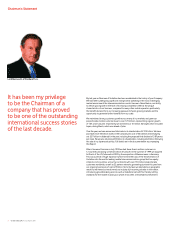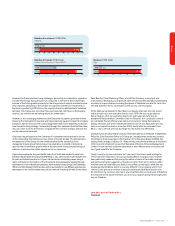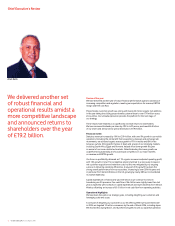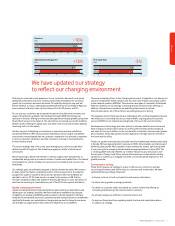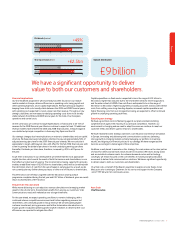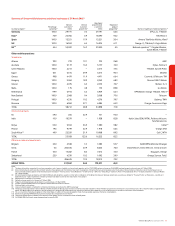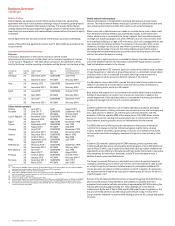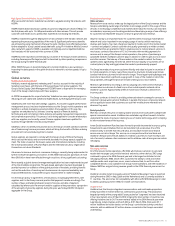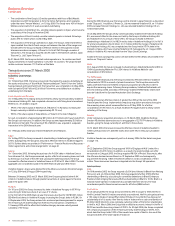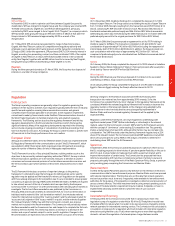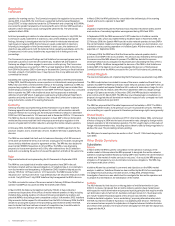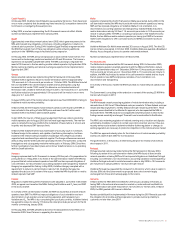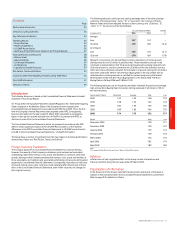Vodafone 2006 Annual Report Download - page 17
Download and view the complete annual report
Please find page 17 of the 2006 Vodafone annual report below. You can navigate through the pages in the report by either clicking on the pages listed below, or by using the keyword search tool below to find specific information within the annual report.
Vodafone Group Plc Annual Report 2006 15
High Speed Downlink Packet Access (“HSDPA”)
After successful field tests, Vodafone has started to upgrade existing 3G networks with
HSDPA.
HSDPA enables data transmission speeds of up to two megabits per second (“Mbps”) in
the first phase, with up to 14.4 Mbps achievable with later releases. This will provide
customers with faster access speeds than experienced on existing 3G networks.
HSDPA is enabled through the deployment of new software in the 3G radio network and
expanding the processing capabilities of the node B. Significant performance benefits
are achieved by using mechanisms that use the radio interface more effectively and are
further adapted to ‘bursty’ packet based data traffic using IP. A Vodafone Mobile Connect
data card which supports HSDPA is available commercially, and compatible Vodafone
live! handsets will be launched in the summer of 2006.
HSDPA has been launched commercially by a number of the Group’s mobile operations,
including Germany and Portugal, and will be launched by other operating companies in
the Group during the 2007 financial year.
While HSDPA focuses on downlink (network to mobile), Vodafone is also working on
improving the data speeds in the uplink (mobile to network) to achieve speeds of up to
384kbps.
Global services
Supply chain management
Handsets, network equipment, marketing and IT services account for the majority of
Vodafone’s purchases, with the bulk of these purchases from global suppliers. The
Group’s Global Supply Chain Management (“GSCM”) team is responsible for managing
most of the Group’s relationships with these suppliers.
As GSCM has expanded its scope of activities, Vodafone has seen significant progress in
reducing per unit capital and operational expenditures, by leveraging the Group’s scale.
GSCM works with more than 250 strategic suppliers. A consistent supplier performance
management process has been implemented across the Group’s mobile operations and
Vodafone is actively managing a growing number of key suppliers in this way. Key
suppliers are evaluated across six areas, covering aspects of financial stability,
technological and commercial criteria, delivery and quality management requirements
and corporate responsibility. This process is also being applied to consider relationships
with new suppliers, and recently several Chinese suppliers have been qualified for
business through GSCM’s China Sourcing Initiative.
GSCM also strives to identify best practice across the Group’s mobile operations with the
aim of harmonising business processes, which will bring the benefits of further reducing
procurement costs and reducing time to market.
Global suppliers are required to comply with the Group’s Code of Ethical Purchasing
which sets out the labour and environmental standards the Group expects suppliers to
meet. The Code is based on the Group’s values and international standards, including
the Universal Declaration of Human Rights and the International Labour Organisation
Conventions on Labour Standards.
A business-to-business electronic commerce strategy is currently being implemented to
further increase transparency and control. In the 2006 financial year, purchases of more
than £0.8 billion have been effected through e-auctions, driving significant cost savings.
More recently, a global demand management application has been implemented as part
of the One Vodafone programme. This web-based application has been developed to
provide improved co-ordination of the global purchase of handsets, providing benefits
such as the reduction of inventory and obsolescence risk, improved availability and
improved effectiveness to allow the Group to respond better to market changes.
It is the Group’s policy to agree terms of transactions, including payment terms, with
suppliers and it is the Group’s normal practice that payment is made accordingly. The
number of days outstanding between receipt of invoices and date of payment,
calculated by reference to the amount owed to suppliers at the year end as a proportion
of the amounts invoiced by suppliers during the year, was 36 days (2005: 35 days) in
aggregate for the Group.
Products and services
Voice services
Revenue from voice services makes up the largest portion of the Group’s revenue and the
Group is undertaking a wide range of activities to encourage growth in the usage of these
services. In increasingly competitive local markets where value for money is an important
consideration, improving use of existing products and developing a range of new offerings
for customers has helped the Group to continue to grow total voice revenue.
Value for money is an important factor for customers when choosing a mobile phone
network and is also important in encouraging usage of services whilst maximising
revenue and margins. Two main charging or payment models exist in the mobile market
– contract and prepaid. Contract customers are usually governed by a written contract
and credit facilities are granted to them to enable access to mobile network services. In
most cases, contracts have a term of 12 to 24 months with monthly payments for
services and, in many of the Group’s mobile operations, the option of purchasing a
subsidised handset. A prepaid customer pays in advance in order to gain access to voice
and other services. The take-up of these models in the markets in which the Group
operates varies significantly, from the US, where the vast majority of customers are on
contract plans, to Italy and Egypt, where the market is predominantly prepaid.
The Group has made pricing more customer friendly and value inclusive in a number of
its mobile operations. In many cases, these new price structures include large minute
bundles that allow customers to talk more for longer. These larger bundle packages and
promotions have driven significant usage growth in many of the markets in which the
Group operates, although the price per minute is falling across most markets.
Revenue is generated by incoming as well as outgoing calls. Interconnect revenue is
received when a customer of a fixed line or other mobile operator network calls a
Vodafone customer. Approximately a fifth of mobile voice revenue is derived from
incoming calls.
The Group continues to invest in providing enhanced network coverage for services in
response to Group-wide customer feedback. In parallel, the Group is improving network
service quality to ensure that customers can use their mobile phone whenever and
wherever they want.
Social products
Work has continued this year on making mobile services more accessible to people with
special communication needs. Vodafone has undertaken significant research to better
understand the levels of exclusion relating to use of mobile technology, which is helping
to inform relevant areas of the business.
A new Social Investment Fund has been formed to provide incremental resources going
forward and to seed initiatives that can demonstrate high social value. One of the
initiatives likely to benefit from this is M-pesa, an innovative mobile micro-finance
service now on trial in Kenya. This service, run in conjunction with a local bank and
Vodafone’s Kenyan joint venture, Safaricom, enables customers to move money in and
out of accounts, between other customers and to withdraw cash, all using secure mobile
messaging.
Non-voice services
Messaging services
All of the Group’s mobile operations offer SMS, which allows customers to send and
receive text messages using mobile handsets and various other devices. SMS usage
continued to grow in the 2006 financial year and is the largest contributor to total
messaging revenues. MMS, which offers customers the ability to send and receive
multiple media, such as pictures, music, sound, video and text, to and from other
compatible devices is also available in all Group mobile operations, with the exception of
Albania. MMS has enjoyed strong revenue growth in the 2006 financial year across the
Group.
Vodafone’s mobile instant messaging service (“Vodafone Messenger”) was re-launched
during November 2005 in Italy, Spain and the Netherlands and is currently available in
11 countries. The service has full compatibility with Microsoft’s MSN Messenger in order
to address growing customer needs for instant communications.
Vodafone live!
Vodafone live!, the Group’s integrated communications and multimedia proposition
initially launched in October 2002, has continued to grow strongly. The proposition,
targeted primarily at the young adult (“young active fun”) segment, has been launched
in four new markets since 31 March 2005, bringing the total number of countries now
offering Vodafone live! to 24. The new markets added in the 2006 financial year were
Luxembourg, Iceland, Cyprus and South Africa. At 31 March 2006, there were 27.1
million Vodafone live! active devices on the Group’s controlled and jointly controlled
networks, with an additional 5.9 million devices connected in the Group’s associated
undertakings.
Business


